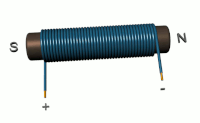
Photo from wikipedia
Self-sensing techniques are a commonly used approach for electromagnetic actuators since they allow the removal of position sensors. Thus, costs, space requirements, and system complexity of actuation systems can be… Click to show full abstract
Self-sensing techniques are a commonly used approach for electromagnetic actuators since they allow the removal of position sensors. Thus, costs, space requirements, and system complexity of actuation systems can be reduced. A widely used parameter for self-sensing is the position-dependent incremental inductance. Nevertheless, this parameter is strongly affected by electromagnetic hysteresis, which reduces the performance of self-sensing. This work focuses on the design of a hysteresis-compensated self-sensing algorithm with low computational effort. In particular, the Integrator-Based Direct Inductance Measurement (IDIM) technique is used for the resource-efficient estimation of the incremental inductance. Since the incremental inductance exhibits a hysteresis with butterfly characteristics, it first needs to be transformed into a B-H curve-like hysteresis. Then, a modified Prandtl–Ishlinskii (MPI) approach is used for modeling this hysteretic behavior. By using a lumped magnetic circuit model, the hysteresis of the iron core can be separated from the air gap, thus allowing a hysteresis-compensated estimation of the position. Experimental studies performed on an industrial switching actuator show a significant decrease in the estimation error when the hysteresis model is considered. The chosen MPI model has a low model order and therefore allows a computationally lightweight implementation. Therefore, it is proven that the presented approach increases the accuracy of self-sensing on electromagnetic actuators with remarkable hysteresis while offering low computational effort which is an important aspect for the implementation of the technique in cost-critical applications.
Journal Title: Energies
Year Published: 2021
Link to full text (if available)
Share on Social Media: Sign Up to like & get
recommendations!